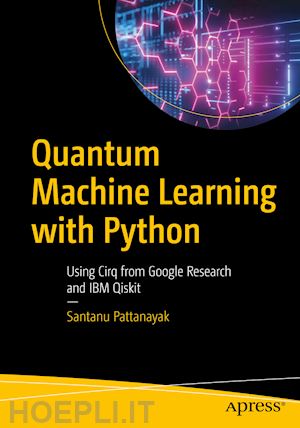
Questo prodotto usufruisce delle SPEDIZIONI GRATIS
selezionando l'opzione Corriere Veloce in fase di ordine.
Pagabile anche con Carta della cultura giovani e del merito, 18App Bonus Cultura e Carta del Docente
Chapter 1: Introduction to Quantum Mechanics and Quantum Computing
Chapter Goal: Introduce the concept of Quantum mechanics and Quantum computing to the readers
No of pages 50-60
Sub-Topics
1. Introduction to Quantum computing
2. Quantum bit and its realization
3. Quantum superposition and Quantum entanglement
4. Bloch Sphere representation of Qubit
5. Stern Gerlach Experiment
6. Bell State
7. Dirac Notations
8. Single Qubit Gates
9. Multiple Qubit Gates
10. Quantum No Cloning Theorem
11. Measurement in different basis
12. Quantum Teleportation
13. Quantum parallelism with Deuth Jozsa
14. Reversibility of quantum computing
Chapter 2: Mathematical Foundations and Postulates of Quantum Computing
Chapter Goal: Lays the mathematical foundation along with the postulates of Quantum computingNo of pages 50-60
Sub -Topics
1. Topics from Linear algebra2. Pauli Operators
3. Linear Operators and their properties
4. Hermitian Operators
5. Normal Operators
6. Unitary Operators
7. Spectral Decomposition
8. Linear Operators on Tensor Product of Vectors
9. Exponential Operator
10. Commutator Anti commutator Operator
11. Postulates of Quantum Mechanics
12. Measurement Operators
13. Heisenberg Uncertainty Principle14. Density Operators and Mixed States
15. Solovay-Kitaev Theorem and Universality of Quantum gates
Chapter 3: Introduction to Quantum Algorithms
Chapter Goal: Introduce to the readers Quantum algorithms to express the Quantum computing supremacy over classical computation
No of pages: 70-80
Sub - Topics:1. Introduction to Cirq and Qiskit
2. Bell State creation and measurement in Cirq and qiskit3. Quantum teleportation Implementation
4. Quantum Random Number generator
5. Deutsch Jozsa Implementation
8. Hadamard Sampling
6. Bernstein Vajirani Algorithm Implementation
7. Bell’s Inequality Implementation
8. Simon’s Algorithm of secret string search Implementation
9 Grover’s Algorithm Implementation
10. Algorithmic complexity in Quantum and Classical computing paradigm
Chapter 4: Quantum Fourier Transform Related Algorithms
Goal: Introduce to the readers Quantum Fourier related algorithms
No of pages: 60-70Sub - Topics:
1. Fourier Series
2. Fourier Transform
3. Discrete Fourier Transform4. Quantum Fourier Transform(QFT)
5. QFT implementation
6. Hadamard Transform as Fourier Transform7. Quantum Phase Estimation(QPE)
8. Quantum Phase Estimation Implementation
9. Error Analysis in Quantum Phase Estimation
10. Shor’s Period Finding Algorithm and Factoring
11. Period Finding Implementation
12. Prime Factoring and Implementation
PART 2
Chapter 5: Introduction to Quantum Machine Learning
Goal: Introduce to the readers Quantum machine learning paradigmNo of pages: 60-70
Sub - Topics:
1. Harrow, Hassidim and Lloyd Algorithm (HHL) for solving Linear Equation2. HHL algorithm Implementation
3. Quantum Linear Regression and Implementation
4. Quantum SWAP Test for dot product Computation
5. Quantum SWAP Test Implementation
6. Quantum Amplitude Scaling
7. Quantum Euclidean Distance Computation
8. Quantum Euclidean Distance Implementation
9. Quantum K means
10. Quantum K means Implementation
11. Quantum Random Access Memory(QRAM)
12. Quantum Principle Component Analysis
13. Quantum Support Vector Machines
14. Quantum Least Square Support Vector Machines(LS -SVM)
15. Least Square SVM Implementation
Chapter 6: Quantum Deep Learning and Quantum Optimization Based Algorithms
Goal: Introduce to the readers Quantum deep learning algorithms and Quantum Optimization Based Algorithms
No of pages: 40-50
Sub - Topics:1. Quantum Neural network and Implementation
2. Quantum Convolutional Neural Network and Implementation
3. Variational Quantum Eigen solvers(VQE)
4. Graph Coloring Problem using VQE
5. Travelling Salesman problem using VQE
Chapter 7: Quantum Adiabatic Processes and Quantum based Optimization.
Santanu Pattanayak works as a staff machine learning specialist at Qualcomm Corp R&D and is an author of the book “Pro Deep Learning with TensorFlow” published by Apress. He has around 12 years of work experience and has worked at GE, Capgemini, and IBM before joining Qualcomm. He graduated with a degree in electrical engineering from Jadavpur University, Kolkata and is an avid math enthusiast. Santanu has a master’s degree in data science from Indian Institute of Technology (IIT), Hyderabad. He also participates in Kaggle competitions in his spare time where he ranks in top 500. Currently, he resides in Bangalore with his wife.











Il sito utilizza cookie ed altri strumenti di tracciamento che raccolgono informazioni dal dispositivo dell’utente. Oltre ai cookie tecnici ed analitici aggregati, strettamente necessari per il funzionamento di questo sito web, previo consenso dell’utente possono essere installati cookie di profilazione e marketing e cookie dei social media. Cliccando su “Accetto tutti i cookie” saranno attivate tutte le categorie di cookie. Per accettare solo deterninate categorie di cookie, cliccare invece su “Impostazioni cookie”. Chiudendo il banner o continuando a navigare saranno installati solo cookie tecnici. Per maggiori dettagli, consultare la Cookie Policy.